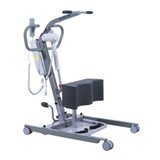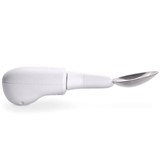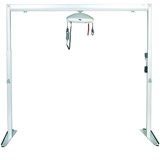Each senior in aged care has different mobility needs, and the right-standing lifter can make a big difference. Standing lifters allow elderly individuals to retain a degree of self-reliance, enabling safer transitions and movements with minimal assistance. Choosing a suitable standing lifter can improve the quality of care for the elderly. In this article, we’ll discuss selecting the best-standing lifter to support the elderly while ensuring safety and ease for caregiver.
What is a Standing Hoist Lifter?
A standing hoist or lifter is designed to help people with limited mobility transition from sitting to standing, especially the elderly. It provides essential support for patients who can still use their legs but need assistance to stand safely. Standing lifters are commonly used in aged care settings to promote independence while reducing the physical strain on caregivers.


Find the right Standing Hoist & Lifter
Compare quotes from expert Australian suppliers and make the best choice. It's free, quick and easy!
How It Differs from Other Mobility Aids
Standing hoists differ from other mobility aids like wheelchairs and transfer hoists.
-
Wheelchairs: Designed for seated mobility and transportation, they do not help with standing.
-
Transfer Hoists: Lift patients entirely off the ground for transfers between locations, typically for those with limited mobility.
-
Standing Lifters: Help users, especially the elderly, achieve and maintain a standing position, allowing them to bear weight and move short distances.
Functions and Benefits for Elderly Patients with Limited Mobility
The primary function of a standing hoist is to provide safe support while standing. It allows elderly individuals to regain mobility securely. Standing lifters usually include leg supports and adjustable heights to meet various needs.
Key benefits include:
-
Improved Independence: Helps elderly patients stand and move, promoting self-reliance.
-
Reduced Injury Risk: Lowers the chance of falls during transitions, ensuring patient and caregiver safety.
-
Rehabilitation: Assists elderly individuals in maintaining or rebuilding leg strength, aiding their recovery and overall health.
-
Caregiver Support: Eases the physical demands on caregivers, making transfers safer and reducing their risk of injury.
Choosing the Right Weight Capacity and Features for a Standing Hoist
a. Importance of Weight Capacity
A higher weight capacity allows the hoist to accommodate a wider range of residents, making it versatile for various needs. However, increases in weight capacity often lead to larger lift sizes, which can limit their usefulness in tight spaces, such as bathrooms.
b. Base Widening Mechanisms
There are two types of base-widening mechanisms to consider:
- Powered Base Widening: This option allows caregivers to widen the lift base with a button, making it easier to manoeuvre in tight spaces.
- Manual Base Widening: This requires the caregiver's weight to widen the base, which can help reduce strain on the caregiver but may require more physical effort.
c. Emergency Controls and Safety Features
Emergency controls are essential for electronic lifts, ensuring that caregivers can quickly stop the lift in an emergency. Additionally, a manual override feature is important, as it allows for the safe movement of residents during power loss situations.
d. Base Dimensions and Stability
Base dimensions play a significant role in the lift's maneuverability. Shorter base lengths and widths enable better navigation in confined areas, while a wide open base provides stability during use. Some lifts even come with scale attachments that allow caregivers to weigh residents during transfers, helping to monitor weight and reduce the risk of injury.
e. Base Clearance Considerations
Consider base clearance for low beds, as they may require higher base clearance for proper operation. Ensuring the bed's height allows for the lift placement helps staff maintain a comfortable position when applying or removing slings.
f. Making the Right Choice
When choosing a sit-to-stand hoist, it's crucial to ensure that the patient's weight capacity exceeds the user's weight. This prevents accidents or equipment failure during use. Look for hoists with adjustable features and safety elements, such as emergency stop buttons, secure locking mechanisms, and padded supports. Finally, opting for hoists with intuitive controls can make operation easier for users and caregivers, enhancing the overall experience for everyone involved.


Find the right Standing Hoist & Lifter
Compare quotes from expert Australian suppliers and make the best choice. It's free, quick and easy!
Tips for Using a Standing Hoist Machine Safely and Effectively
-
Check the Equipment: Ensure the standing hoist machine works well before using it. Inspect the sling for any damage, and refer to the manual to confirm the weight capacity of the hoist. Make sure the patient's weight is within the machine's limits.
-
Check the Patient: Ensure they are seated securely at the border of a bed or chair, preparing them for a smooth transition using the standing hoist machine.
-
Attach the Sling: Carefully attach the sling to the hoist with disengaged brakes. Verify that it is securely fastened to prevent any accidents during the lift.
-
Lift the Patient: Distribute the patient’s weight evenly across the sling and use the standing hoist machine to lift them gradually. Remember to lift them just enough to be fully suspended, avoiding sudden movements that could cause discomfort or injury.
-
Transfer the Patient: While transferring the patient, closely monitor their stability and comfort. Standing hoist machines are typically designed for shorter transfers rather than long-distance moves.
-
Never Leave the Patient Unattended: Stay with the patient throughout the process. Improper use or leaving the patient unattended while using the standing hoist machine can result in serious injury or even death. Always maintain full supervision.
Conclusion
Choosing the right standing lifter enhances the care of elderly individuals with mobility issues. To make the best selection, focus on the lifter's weight capacity, safety features, and ease of use. Regular checks and attentive supervision ensure safe transfers and minimise risks.
Find Your Ideal Standing Hoist Machine!
Ready to improve the quality of care for elderly individuals with mobility challenges? Get started by requesting quotes for standing hoists from MedicalSearch. Compare options, features, and prices to find the perfect solution for your needs. Don’t wait—take the next step toward enhancing mobility and independence today! Get quotes for a standing hoist now!
FAQ:
-
What is a standing hoist?
A standing hoist helps people with limited mobility transition from sitting to standing, providing support for those who can use their legs but need assistance.
-
How is a standing hoist different from other aids?
Standing hoists allow users to stand and move short distances, while wheelchairs are for seated mobility and transfer hoists lift patients completely.
.jpeg)








-205x205.jpeg)